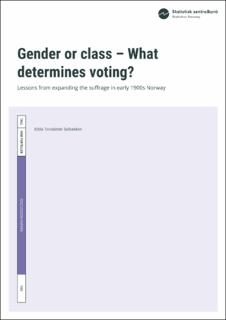Gender or class – What determines voting? Lessons from expanding the suffrage in early 1900s Norway
Working paper
Permanent lenke
https://hdl.handle.net/11250/3016829Utgivelsesdato
2022-09Metadata
Vis full innførselSamlinger
- Discussion Papers [1003]
Sammendrag
Previous literature has found that extending the suffrage to both females and poorer voters increases
the supply of public goods. This paper investigates whether the difference in voting between men
and women can be explained by differences in income alone, or if there exist gender specific
differences in preferences. I exploit two key features of the expansion of suffrage in municipality
elections in early 20th century Norway. First, the time at which people gained the right to vote
depended on both their gender and their household income. Second, the income threshold for
suffrage was set nationally, creating variation across municipalities in the share of new voters
following each extension of the suffrage. This variation allows me to estimate separate effects for the
change in supply of health personnel following the extension of suffrage to poor men, rich women,
and poor women, respectively. I find that the enfranchisement of both poor men and rich women
increases the supply of doctors relative to when only rich men had the right to vote. These results are
consistent with gender specific preferences for health services to the community.

